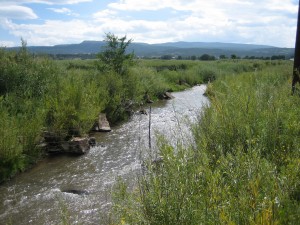More art from the hard drive reorganization. This is the headwaters of the Little Colorado River from another Lissa-John road trip (we road trip well) through Arizona. It’s just outside Springerville, and yes, it’s green, and flowing. (The Little Colorado is more famous for brown, and its relative lack of flowing.)
The development of the Little Colorado basin by 19th century Mormon immigrants is a fascinating bits of western water history. William Abruzzi has done some interesting work looking at the Mormons’ approach, which involved sharing of what one might call “ecological risk” across communities. From the Land Use History of North American project:
According to Abruzzi, it was the region’s numerous widely separated and structurally distinct local habitats that offered potential for widespread agricultural productivity. For example, a particularly wet 1890 agricultural season caused crops to rot at Alpine and led to the loss of dams at Snowflake, Taylor, Woodruff, and St. Joseph, but increased production at most other locations.
The particular genius that the Mormons brought to this region, as well as to others, was the development of a cooperative resource redistribution system that economically integrated the different farms and villages in the basin and enabled them to withstand otherwise devastating crop failures and dam losses. This took the form of a series of productive enterprises jointly operated by the early United Order towns in the lower valleys of the Little Colorado River, and a second system operated through the collection and distribution of the tithing resources among settlements dispersed throughout the river basin.

